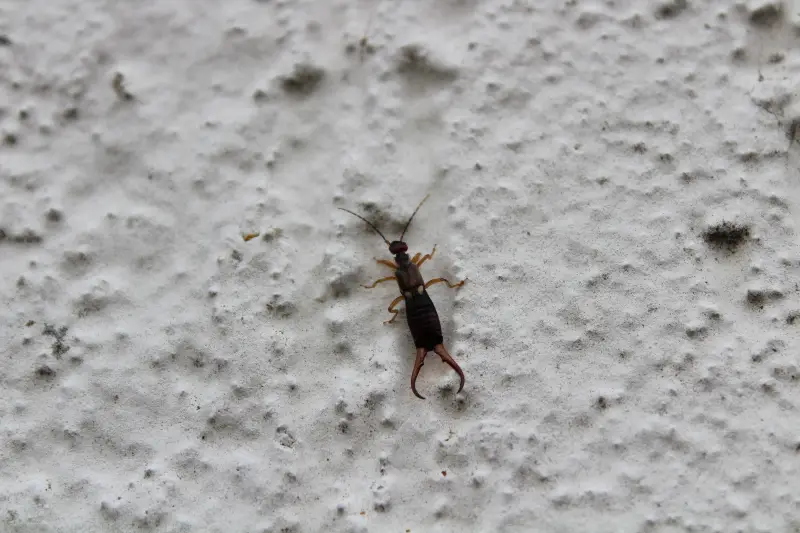When you see earwigs in your bathroom, it may cause a moment of discomfort or even alarm. While earwigs are more of a nuisance than a dangerous pest, their presence is often unwelcome, especially in the sanctity of your personal space.
Fortunately, as a homeowner, there are several effective methods both natural solutions and traditional pest control methods you can use to rid your bathroom of these pesky insects.
1. Address Moisture
One of the primary reasons earwigs find their way into your bathroom is due to the high levels of moisture present. These insects are attracted to damp and humid environments, so the first step in addressing an earwig infestation is to reduce these conditions.
- Ensure that your bathroom is well-ventilated. Use exhaust fans during and after showers or baths to remove moist air.
- Consider using a dehumidifier in your bathroom if the humidity levels are consistently high.
- Wipe down wet surfaces after use and keep towels, rugs, and curtains dry.
- Clear out any standing water in sinks, tubs, and showers promptly.
By maintaining a drier environment, you make your bathroom less inviting for earwigs. Reducing moisture not only helps to prevent earwigs but also other pests like mold and mildew, improving the overall hygiene and comfort of your bathroom.
2. Repair Leaks
Leaky pipes and fixtures create the moisture that earwigs seek. Repairing leaks is a key step in making your bathroom less attractive to these pests.
- Inspect under sinks, behind toilets, and around tubs for any signs of moisture.
- Address any leaks immediately, no matter how small they may seem, to prevent dampness from attracting earwigs.
- Consider replacing old pipes or fixtures that have a history of leaking.
- Regularly check seals and caulking around your bathroom fixtures and repair any that have deteriorated.
3. Use Diatomaceous Earth
Diatomaceous earth is a natural pest control option that’s non-toxic to humans and pets but lethal to earwigs.
Made from the fossilized remains of tiny aquatic organisms called diatoms, its microscopic sharp edges can cut through the exoskeletons of earwigs, leading to dehydration and death.
- Sprinkle a thin layer of food-grade diatomaceous earth along baseboards, under sinks, around the toilet, and any other areas where you’ve noticed earwigs.
- Repeat the process every few days until you no longer spot earwigs.
Since diatomaceous earth is less effective when wet, it’s important to apply it in dry areas and reapply after cleaning or any water exposure.
4. Traditional Pesticides
When natural methods are not enough, traditional pesticides provide a stronger solution. It’s vital to choose products specifically designed to target earwigs and apply them according to the manufacturer’s instructions.
- Aerosol insecticides can be used to spray in cracks and crevices where earwigs are suspected to hide.
- Liquid concentrates can be diluted and used to treat larger areas or create a barrier around the perimeter of the bathroom.
- Granular insecticides can be sprinkled in dry areas and along entry points to prevent earwigs from entering the space.
Be cautious when using traditional pesticides, especially in areas frequently used by children and pets. Ensure proper ventilation and consider the potential for toxic exposure before application.
5. Alcohol Spray
An alcohol spray is a simple and effective home remedy for eliminating earwigs. The alcohol works by dehydrating the insects upon contact, causing them to die.
- Mix equal parts of rubbing alcohol and water in a spray bottle and shake well.
- Avoid over-spraying, as excessive moisture can attract more earwigs.
Use this method as a direct treatment when you see earwigs in the bathroom. It’s a quick fix that can offer immediate results.
6. Clean Gutters and Drainpipes
Earwigs outside your home can find their way indoors through tiny gaps and cracks. One way to minimize the likelihood of this happening is to keep your gutters and drainpipes clean.
- Regularly remove leaves and debris from your gutters to prevent earwigs from nesting.
- Make sure downspouts are clear and water can flow freely away from your home.
- Check that gutter guards are intact to stop earwigs and other insects from finding a way in.
- Consider extending your downspouts if they are not directing water far enough away from your foundation.
Maintaining your gutters and drainpipes reduces the moist conditions that attract earwigs, and also helps to prevent them from being a bridge into your home.
7. Soapy Water
Soapy water is an inexpensive and eco-friendly method to deal with earwigs on contact.
- Mix a few drops of dish soap with water in a spray bottle.
- Spray the solution directly on the earwigs when you see them.
The soap breaks down the earwigs’ waxy exoskeleton and causes them to dehydrate. Plus, this method is safe to use around children and pets, making it an excellent option for indoor pest control.
8. Clean Up Your Yard
The outdoor environment can greatly contribute to indoor pest problems. Keeping your yard tidy is an effective preventative measure.
- Trim plants and shrubs away from your home’s exterior to eliminate moist, shaded areas where earwigs thrive.
- Remove yard debris such as leaf piles, mulch, and logs where earwigs might take shelter.
- Rake your yard regularly to disturb any potential hiding places.
By making your yard less appealing to earwigs, you’ll reduce the chances that they will make their way into your bathroom.
9. Set Traps
Traps can be effective tools in monitoring and controlling earwig populations.
- Use light traps, which attract earwigs with a bright light and then trap them.
- Sticky traps can be placed in areas where earwigs are frequently seen or suspected to travel.
Regularly check and replace these traps to continuously manage the earwig situation in your bathroom.
10. DIY Trap
Creating a do-it-yourself (DIY) trap is an excellent way to catch and remove earwigs from your bathroom without harmful chemicals.
- Roll up a damp newspaper or cut a soda bottle in half and fill it with a bit of soapy water.
- Place traps near suspected entry points in the evenings since earwigs are nocturnal.
- Check traps the next morning, and dispose of any captured earwigs.
These traps work because earwigs are attracted to the moist, dark environment. Once they crawl inside, they get trapped and can be easily removed from your bathroom.
11. Remove Food and Harborage Sources
Earwigs also come into your bathroom in search of food. Removing their food sources can help in controlling their population.
- Ensure that any pet food is sealed and put away at night.
- Clean up food spills immediately and maintain a regular cleaning schedule.
- Regularly inspect and remove any decaying organic matter, like wet wood or leaves.
Eliminating places where earwigs can hide and breed is just as important. Keep areas under sinks uncluttered, and seal gaps around pipes and fixtures where earwigs might nest.
12. Use Boric Acid
Boric acid is a natural substance that can be an effective pesticide against earwigs. It disrupts their digestive system and can be fatal to them when ingested.
- Sprinkle a thin layer of boric acid powder in areas where earwigs are likely to hide, such as under sinks and along bathroom baseboards.
- Keep it away from areas where pets and children might reach, as it can be harmful if ingested in significant quantities.
Boric acid can lose its potency if it becomes damp, so it’s important to apply it in dry areas and reapply after any cleaning or exposure to moisture.
13. Vacuum Up
A straightforward method to immediately remove earwigs from your bathroom is to vacuum them up.
- Use a vacuum with a hose attachment to reach into cracks, corners, and other hideouts where earwigs gather.
- Seal and dispose of the vacuum bag outside immediately to prevent earwigs from escaping back into your home.
Vacuuming not only removes the visible earwigs but also can suck up any eggs that might be lurking out of sight.
14. Seal Entry Points
Preventing earwigs from entering your home in the first place is one of the most effective strategies.
- Seal up cracks and crevices in the walls, especially around windows, doors, and plumbing fixtures.
- Install weather stripping around doors and windows to close up any gaps.
- Use caulk or foam sealant to block entry points in your bathroom where earwigs might squeeze through.
15. Use Essential Oils
Certain essential oils have been reported to repel earwigs due to their strong scent.
- Create a repellent spray by adding a few drops of peppermint or eucalyptus oil to a spray bottle of water.
- Spray around windows, doors, and other potential entry points in your bathroom.
Since essential oils are natural, they are a safe alternative to chemical repellents, and they can also give your bathroom a fresh, pleasant scent.
16. Employ Natural Predators
Inviting nature’s own pest control agents can be an effective long-term strategy to handle earwigs.
- Attract birds to your garden by setting up bird feeders or nesting boxes, as many bird species feed on insects like earwigs.
- Promote a healthy population of toads and lizards in your yard, which are also known to eat earwigs.
While this approach may not entirely solve an earwig problem in your bathroom, maintaining a biodiverse garden with natural predators will help regulate earwig populations outdoors, ultimately reducing the likelihood of them venturing inside.
Conclusion
Tackling earwigs in your bathroom requires a multifaceted approach that addresses both eradication and prevention.
By minimizing moisture, employing both DIY and commercial traps, utilizing natural repellents like diatomaceous earth, boric acid, and essential oils, and taking steps to exclude earwigs from entering, you can reclaim your bathroom from these unwelcome guests.
Remember to also keep an eye on outdoor factors such as yard cleanliness and proper gutter maintenance, which can significantly influence indoor pest issues. Patience and persistence are key – it may take several attempts with different methods to completely eliminate an earwig problem.





